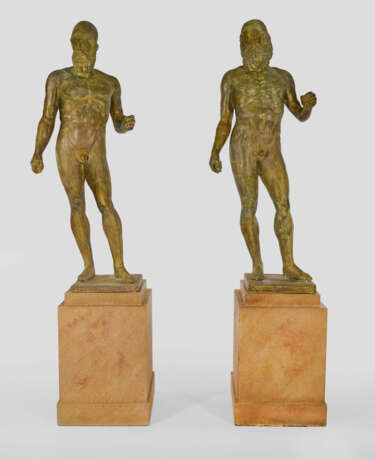ID 1341944
Lot 2773 | Bronzestatuen von Riace (sog. Riace-Krieger)
Estimate value
€ 24 000 – 48 000
Gegenstücke. Bronze, patiniert; gefasste Holzsockel. Guss Ende 20. Jh., nach den beiden berühmten lebensgroßen bzw. überlebensgroßen, griechischen Bronzefiguren aus der Mitte des 5. Jahrhunderts v. Chr., die 1972 vor der Küste bei Riace in Italien gefunden wurden und sich seit 1981 im Museo Archeologico Nazionale di Reggio Calabria befinden. Es sind im leichten Kontrapost stehende, männliche Aktfiguren, die beide einen Vollbart tragen, auf dem Kopf ein Stirnband bzw. einen Helm. Ursprünglich waren sie wohl bewaffnet und hielten, wie es die Haltung ihrer Arme annehmen lässt, nicht mehr erhaltene Holzschilde und Hiebwaffen, eine Schleuder oder ähnliches. Die beiden Figuren wurden als Krieger, Athleten bzw. Gladiatoren oder sogar als Götter gedeutet, möglicherweise waren es ursprünglich Weihegeschenke an einen Tempel. Aufgrund der gleichermaßen realistischen wie idealtypischen Darstellungsweise ist eine Datierung in die hochklassische Periode der Griechischen Kunst, also um 460-430 v. Chr. wahrscheinlich, als ihr Schöpfer wurde der von Plinius erwähnte Pythagoras von Rhegion, ein Bildhauer des 5. Jh. v. Chr. vermutet. Sie gehören zu den nur sieben erhaltenen griechischen bzw. großgriechischen Bronzestatuen. H. 182-186 cm.
Riace bronzes (also called the Riace warriors). Patinated bronze statues on painted wooden bases. Cast late 20th century after the well-known ancient Greek bronze statues (about 460-450 BC, that were found in the sea in 1972 near Riace, Calabria, Southern Italy, now in the Museo Nazionale della Magna Grecia in the nearby city of Reggio Calabria).
| Auction house category: | Sculptures |
|---|
| Auction house category: | Sculptures |
|---|
| Address of auction |
Kunstauktionshaus Schloss Ahlden GmbH Große Str. 1 29691 Ahlden(Aller) Germany | ||||||||||||||
|---|---|---|---|---|---|---|---|---|---|---|---|---|---|---|---|
| Preview |
| ||||||||||||||
| Phone | +49 5164 80100 | ||||||||||||||
| Buyer Premium | 25.0 | ||||||||||||||
| Conditions of purchase | Conditions of purchase | ||||||||||||||
| Business hours | Business hours
|



